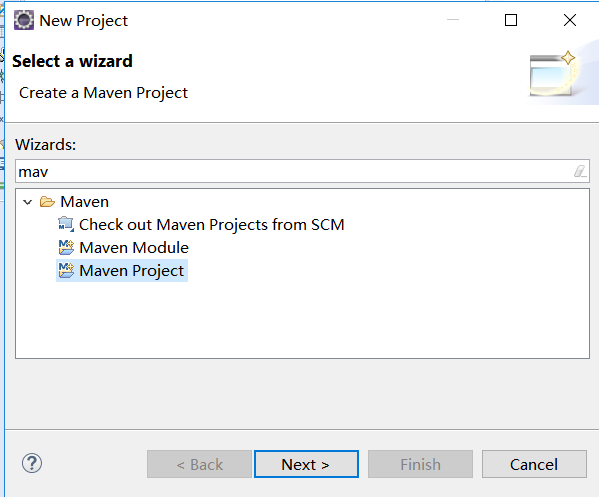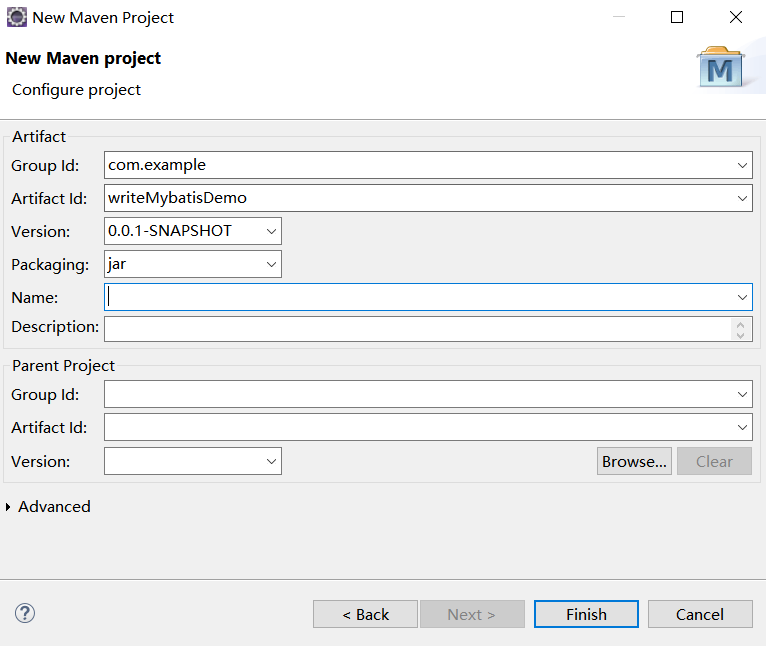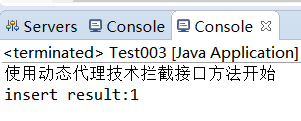一、实现手写Mybatis三个难点
1、接口既然不能被实例化?那么我们是怎么实现能够调用的?
2、参数如何和sql绑定
3、返回结果
下面是Mybatis接口

二、Demo实现
1、创建Maven工程(开发工具Eclipse)

下一步

下一步

然后点击“完成”
2、配置pom.xml
<project xmlns="http://maven.apache.org/POM/4.0.0" xmlns:xsi="http://www.w3.org/2001/XMLSchema-instance" xsi:schemaLocation="http://maven.apache.org/POM/4.0.0 http://maven.apache.org/xsd/maven-4.0.0.xsd"> <modelVersion>4.0.0</modelVersion> <groupId>com.example</groupId> <artifactId>writeMybatisDemo</artifactId> <version>0.0.1-SNAPSHOT</version> <dependencies> <!-- mybatis核心包 --> <dependency> <groupId>org.mybatis</groupId> <artifactId>mybatis</artifactId> <version>3.4.5</version> </dependency> <!-- 引入Spring-AOP等相关Jar --> <dependency> <groupId>org.springframework</groupId> <artifactId>spring-core</artifactId> <version>3.0.6.RELEASE</version> </dependency> <dependency> <groupId>org.springframework</groupId> <artifactId>spring-context</artifactId> <version>3.0.6.RELEASE</version> </dependency> <dependency> <groupId>org.springframework</groupId> <artifactId>spring-aop</artifactId> <version>3.0.6.RELEASE</version> </dependency> <dependency> <groupId>org.springframework</groupId> <artifactId>spring-orm</artifactId> <version>3.0.6.RELEASE</version> </dependency> <dependency> <groupId>org.aspectj</groupId> <artifactId>aspectjrt</artifactId> <version>1.6.1</version> </dependency> <dependency> <groupId>aspectj</groupId> <artifactId>aspectjweaver</artifactId> <version>1.5.3</version> </dependency> <dependency> <groupId>cglib</groupId> <artifactId>cglib</artifactId> <version>2.1_2</version> </dependency> <!-- https://mvnrepository.com/artifact/com.mchange/c3p0 --> <dependency> <groupId>com.mchange</groupId> <artifactId>c3p0</artifactId> <version>0.9.5.2</version> </dependency> <!-- https://mvnrepository.com/artifact/mysql/mysql-connector-java --> <dependency> <groupId>mysql</groupId> <artifactId>mysql-connector-java</artifactId> <version>5.1.37</version> </dependency> <!-- https://mvnrepository.com/artifact/asm/asm --> <dependency> <groupId>asm</groupId> <artifactId>asm</artifactId> <version>3.3.1</version> </dependency> </dependencies> </project>
3、JDBCUtil工具类
package com.exmaple.orm.util;
import java.sql.Connection;
import java.sql.DriverManager;
import java.sql.PreparedStatement;
import java.sql.ResultSet;
import java.sql.ResultSetMetaData;
import java.sql.SQLException;
import java.sql.Statement;
import java.util.ArrayList;
import java.util.HashMap;
import java.util.List;
import java.util.Map;
public final class JDBCUtils {
private static String connect;
private static String driverClassName;
private static String URL;
private static String username;
private static String password;
private static boolean autoCommit;
/** 声明一个 Connection类型的静态属性,用来缓存一个已经存在的连接对象 */
private static Connection conn;
static {
config();
}
/**
* 开头配置自己的数据库信息
*/
private static void config() {
/*
* 获取驱动
*/
driverClassName = "com.mysql.jdbc.Driver";
/*
* 获取URL
*/
URL = "jdbc:mysql://localhost:3306/test?useUnicode=true&characterEncoding=utf8";
/*
* 获取用户名
*/
username = "root";
/*
* 获取密码
*/
password = "123456";
/*
* 设置是否自动提交,一般为false不用改
*/
autoCommit = false;
}
/**
* 载入数据库驱动类
*/
private static boolean load() {
try {
Class.forName(driverClassName);
return true;
} catch (ClassNotFoundException e) {
System.out.println("驱动类 " + driverClassName + " 加载失败");
}
return false;
}
/**
* 专门检查缓存的连接是否不可以被使用 ,不可以被使用的话,就返回 true
*/
private static boolean invalid() {
if (conn != null) {
try {
if (conn.isClosed() || !conn.isValid(3)) {
return true;
/*
* isValid方法是判断Connection是否有效,如果连接尚未关闭并且仍然有效,则返回 true
*/
}
} catch (SQLException e) {
e.printStackTrace();
}
/*
* conn 既不是 null 且也没有关闭 ,且 isValid 返回 true,说明是可以使用的 ( 返回 false )
*/
return false;
} else {
return true;
}
}
/**
* 建立数据库连接
*/
public static Connection connect() {
if (invalid()) { /* invalid为true时,说明连接是失败的 */
/* 加载驱动 */
load();
try {
/* 建立连接 */
conn = DriverManager.getConnection(URL, username, password);
} catch (SQLException e) {
System.out.println("建立 " + connect + " 数据库连接失败 , " + e.getMessage());
}
}
return conn;
}
/**
* 设置是否自动提交事务
**/
public static void transaction() {
try {
conn.setAutoCommit(autoCommit);
} catch (SQLException e) {
System.out.println("设置事务的提交方式为 : " + (autoCommit ? "自动提交" : "手动提交") + " 时失败: " + e.getMessage());
}
}
/**
* 创建 Statement 对象
*/
public static Statement statement() {
Statement st = null;
connect();
/* 如果连接是无效的就重新连接 */
transaction();
/* 设置事务的提交方式 */
try {
st = conn.createStatement();
} catch (SQLException e) {
System.out.println("创建 Statement 对象失败: " + e.getMessage());
}
return st;
}
/**
* 根据给定的带参数占位符的SQL语句,创建 PreparedStatement 对象
*
* @param SQL
* 带参数占位符的SQL语句
* @return 返回相应的 PreparedStatement 对象
*/
private static PreparedStatement prepare(String SQL, boolean autoGeneratedKeys) {
PreparedStatement ps = null;
connect();
/* 如果连接是无效的就重新连接 */
transaction();
/* 设置事务的提交方式 */
try {
if (autoGeneratedKeys) {
ps = conn.prepareStatement(SQL, Statement.RETURN_GENERATED_KEYS);
} else {
ps = conn.prepareStatement(SQL);
}
} catch (SQLException e) {
System.out.println("创建 PreparedStatement 对象失败: " + e.getMessage());
}
return ps;
}
public static ResultSet query(String SQL, List<Object> params) {
if (SQL == null || SQL.trim().isEmpty() || !SQL.trim().toLowerCase().startsWith("select")) {
throw new RuntimeException("你的SQL语句为空或不是查询语句");
}
ResultSet rs = null;
if (params.size() > 0) {
/* 说明 有参数 传入,就需要处理参数 */
PreparedStatement ps = prepare(SQL, false);
try {
for (int i = 0; i < params.size(); i++) {
ps.setObject(i + 1, params.get(i));
}
rs = ps.executeQuery();
} catch (SQLException e) {
System.out.println("执行SQL失败: " + e.getMessage());
}
} else {
/* 说明没有传入任何参数 */
Statement st = statement();
try {
rs = st.executeQuery(SQL); // 直接执行不带参数的 SQL 语句
} catch (SQLException e) {
System.out.println("执行SQL失败: " + e.getMessage());
}
}
return rs;
}
private static Object typeof(Object o) {
Object r = o;
if (o instanceof java.sql.Timestamp) {
return r;
}
// 将 java.util.Date 转成 java.sql.Date
if (o instanceof java.util.Date) {
java.util.Date d = (java.util.Date) o;
r = new java.sql.Date(d.getTime());
return r;
}
// 将 Character 或 char 变成 String
if (o instanceof Character || o.getClass() == char.class) {
r = String.valueOf(o);
return r;
}
return r;
}
public static boolean execute(String SQL, Object... params) {
if (SQL == null || SQL.trim().isEmpty() || SQL.trim().toLowerCase().startsWith("select")) {
throw new RuntimeException("你的SQL语句为空或有错");
}
boolean r = false;
/* 表示 执行 DDL 或 DML 操作是否成功的一个标识变量 */
/* 获得 被执行的 SQL 语句的 前缀 */
SQL = SQL.trim();
SQL = SQL.toLowerCase();
String prefix = SQL.substring(0, SQL.indexOf(" "));
String operation = ""; // 用来保存操作类型的 变量
// 根据前缀 确定操作
switch (prefix) {
case "create":
operation = "create table";
break;
case "alter":
operation = "update table";
break;
case "drop":
operation = "drop table";
break;
case "truncate":
operation = "truncate table";
break;
case "insert":
operation = "insert :";
break;
case "update":
operation = "update :";
break;
case "delete":
operation = "delete :";
break;
}
if (params.length > 0) { // 说明有参数
PreparedStatement ps = prepare(SQL, false);
Connection c = null;
try {
c = ps.getConnection();
} catch (SQLException e) {
e.printStackTrace();
}
try {
for (int i = 0; i < params.length; i++) {
Object p = params[i];
p = typeof(p);
ps.setObject(i + 1, p);
}
ps.executeUpdate();
commit(c);
r = true;
} catch (SQLException e) {
System.out.println(operation + " 失败: " + e.getMessage());
rollback(c);
}
} else { // 说明没有参数
Statement st = statement();
Connection c = null;
try {
c = st.getConnection();
} catch (SQLException e) {
e.printStackTrace();
}
// 执行 DDL 或 DML 语句,并返回执行结果
try {
st.executeUpdate(SQL);
commit(c); // 提交事务
r = true;
} catch (SQLException e) {
System.out.println(operation + " 失败: " + e.getMessage());
rollback(c); // 回滚事务
}
}
return r;
}
/*
*
* @param SQL 需要执行的 INSERT 语句
*
* @param autoGeneratedKeys 指示是否需要返回由数据库产生的键(自增长)
*
* @param params 将要执行的SQL语句中包含的参数占位符的 参数值
*
* @return 如果指定 autoGeneratedKeys 为 true 则返回由数据库产生的键; 如果指定 autoGeneratedKeys
* 为 false 则返回受当前SQL影响的记录数目
*/
public static int insert(String SQL, boolean autoGeneratedKeys, List<Object> params) {
int var = -1;
if (SQL == null || SQL.trim().isEmpty()) {
throw new RuntimeException("你没有指定SQL语句,请检查是否指定了需要执行的SQL语句");
}
// 如果不是 insert 开头开头的语句
if (!SQL.trim().toLowerCase().startsWith("insert")) {
System.out.println(SQL.toLowerCase());
throw new RuntimeException("你指定的SQL语句不是插入语句,请检查你的SQL语句");
}
// 获得 被执行的 SQL 语句的 前缀 ( 第一个单词 )
SQL = SQL.trim();
SQL = SQL.toLowerCase();
if (params.size() > 0) { // 说明有参数
PreparedStatement ps = prepare(SQL, autoGeneratedKeys);
Connection c = null;
try {
c = ps.getConnection(); // 从 PreparedStatement 对象中获得 它对应的连接对象
} catch (SQLException e) {
e.printStackTrace();
}
try {
for (int i = 0; i < params.size(); i++) {
Object p = params.get(i);
p = typeof(p);
ps.setObject(i + 1, p);
}
int count = ps.executeUpdate();
if (autoGeneratedKeys) { // 如果希望获得数据库产生的键
ResultSet rs = ps.getGeneratedKeys(); // 获得数据库产生的键集
if (rs.next()) { // 因为是保存的是单条记录,因此至多返回一个键
var = rs.getInt(1); // 获得值并赋值给 var 变量
}
} else {
var = count; // 如果不需要获得,则将受SQL影像的记录数赋值给 var 变量
}
commit(c);
} catch (SQLException e) {
System.out.println("数据保存失败: " + e.getMessage());
rollback(c);
}
} else { // 说明没有参数
Statement st = statement();
Connection c = null;
try {
c = st.getConnection(); // 从 Statement 对象中获得 它对应的连接对象
} catch (SQLException e) {
e.printStackTrace();
}
// 执行 DDL 或 DML 语句,并返回执行结果
try {
int count = st.executeUpdate(SQL);
if (autoGeneratedKeys) { // 如果企望获得数据库产生的键
ResultSet rs = st.getGeneratedKeys(); // 获得数据库产生的键集
if (rs.next()) { // 因为是保存的是单条记录,因此至多返回一个键
var = rs.getInt(1); // 获得值并赋值给 var 变量
}
} else {
var = count; // 如果不需要获得,则将受SQL影像的记录数赋值给 var 变量
}
commit(c); // 提交事务
} catch (SQLException e) {
System.out.println("数据保存失败: " + e.getMessage());
rollback(c); // 回滚事务
}
}
return var;
}
/** 提交事务 */
private static void commit(Connection c) {
if (c != null && !autoCommit) {
try {
c.commit();
} catch (SQLException e) {
e.printStackTrace();
}
}
}
/** 回滚事务 */
private static void rollback(Connection c) {
if (c != null && !autoCommit) {
try {
c.rollback();
} catch (SQLException e) {
e.printStackTrace();
}
}
}
/**
* 释放资源
**/
public static void release(Object cloaseable) {
if (cloaseable != null) {
if (cloaseable instanceof ResultSet) {
ResultSet rs = (ResultSet) cloaseable;
try {
rs.close();
} catch (SQLException e) {
e.printStackTrace();
}
}
if (cloaseable instanceof Statement) {
Statement st = (Statement) cloaseable;
try {
st.close();
} catch (SQLException e) {
e.printStackTrace();
}
}
if (cloaseable instanceof Connection) {
Connection c = (Connection) cloaseable;
try {
c.close();
} catch (SQLException e) {
e.printStackTrace();
}
}
}
}
}
4、测试JDBC
1)增加测试
public class JdbcTest {
public static void main(String[] args) {
// #{userName} 替换成?
String insertSql = "insert into user(userName,userAge) values(?,?)";
ArrayList<Object> arrayList = new ArrayList<>(); //非线程安全
arrayList.add("Nick");
arrayList.add(30);
int insert = JDBCUtils.insert(insertSql, false, arrayList);
System.out.println("insert:" + insert);
}
}
输出结果

2) 查询测试
public static void query() throws SQLException {
String selectSql = "select * from User where userName=? and userAge= ? ";
ArrayList<Object> arrayList = new ArrayList<>(); //非线程安全
arrayList.add("Nick");
arrayList.add(30);
ResultSet res = JDBCUtils.query(selectSql, arrayList);
while (res.next()) {
String userName = res.getString("userName");
System.out.println("userName:" +userName);
}
}
输出结果:

三、手写Mybatis注解版本框架-环境搭建
1、创建自定义插入注解
package com.example.annotation;
import java.lang.annotation.Documented;
import java.lang.annotation.ElementType;
import java.lang.annotation.Retention;
import java.lang.annotation.RetentionPolicy;
import java.lang.annotation.Target;
/**
* 自定义插入注解
*
*/
@Documented
@Retention(RetentionPolicy.RUNTIME)
@Target(ElementType.METHOD)
public @interface ExtInsert {
String value();
}
2、自定义参数注解
package com.example.annotation;
import java.lang.annotation.Documented;
import java.lang.annotation.ElementType;
import java.lang.annotation.Retention;
import java.lang.annotation.RetentionPolicy;
import java.lang.annotation.Target;
/**
* 自定义参数注解
*
*/
@Documented
@Retention(RetentionPolicy.RUNTIME)
@Target(ElementType.PARAMETER)
public @interface ExtParam {
String value();
}
3、创建接口UserMapper
package com.example.mapper;
import com.example.annotation.ExtInsert;
import com.example.annotation.ExtParam;
//@Mapper
public interface UserMapper {
@ExtInsert("insert into user(userName,userAge) values(#{userName},#{userAge})")
public int insertUser(@ExtParam("userName") String userName, @ExtParam("userAge")Integer userAge);
}
四、基于AOP实现拦截mapper接口
1、使用反射动态拦截 接口方法
package com.example.mybatis.aop;
import java.lang.reflect.InvocationHandler;
import java.lang.reflect.Method;
/**
* 使用反射动态拦截 接口方法
*
*/
public class MyInvocationHandlerMybatis implements InvocationHandler {
private Object object;
public MyInvocationHandlerMybatis(Object object) {
this.object = object;
}
//proxy,代理对象 。 method: 拦截方法 。 args 方法上的参数值
@Override
public Object invoke(Object proxy, Method method, Object[] args) throws Throwable {
System.out.println("使用动态代理技术拦截接口方法开始");
return 1;
}
}
2、创建SqlSession类
package com.example.sql;
import java.lang.reflect.Proxy;
import com.example.mybatis.aop.MyInvocationHandlerMybatis;
public class SqlSession {
//加载Mapper接口
@SuppressWarnings("unchecked")
public static <T> T getMapper(Class<T> classz)
throws IllegalArgumentException, InstantiationException, IllegalAccessException {
return (T) Proxy.newProxyInstance(classz.getClassLoader(),
new Class[]{classz}, new MyInvocationHandlerMybatis(classz));
}
}
3、测试
public class Test003 {
public static void main(String[] args) throws IllegalArgumentException, InstantiationException, IllegalAccessException {
//使用动态代理技术虚拟调用方法
UserMapper userMapper = SqlSession.getMapper(UserMapper.class);
int result = userMapper.insertUser("Larry", 40);
System.out.println("insert result:" + result);
}
}
返回结果

五、@extinsert和@extselect注解基本实现思路
1、ExtSelect 注解
/**
* 自定义查询注解
*
*/
@Documented
@Retention(RetentionPolicy.RUNTIME)
@Target(ElementType.METHOD)
public @interface ExtSelect {
String value();
}
2、ExtInsert 注解
/**
* 自定义插入注解
*
*/
@Documented
@Retention(RetentionPolicy.RUNTIME)
@Target(ElementType.METHOD)
public @interface ExtInsert {
String value();
}
3、User 类
package com.example.entity;
public class User {
private String userName;
private Integer userAge;
public String getUserName() {
return userName;
}
public void setUserName(String userName) {
this.userName = userName;
}
public Integer getUserAge() {
return userAge;
}
public void setUserAge(Integer userAge) {
this.userAge = userAge;
}
@Override
public String toString() {
return "User [userName=" + userName + ", userAge=" + userAge + "]";
}
}
4、UserMapper 接口
public interface UserMapper {
@ExtInsert("insert into user(userName,userAge) values(#{userName},#{userAge})")
public int insertUser(@ExtParam("userName") String userName, @ExtParam("userAge")Integer userAge);
@ExtSelect("select * from User where userName=#{userName} and userAge=#{userAge} ")
User selectUser(@ExtParam("userName") String name, @ExtParam("userAge") Integer userAge);
}
5、 SQL拼接
package com.exmaple.orm.util;
import java.util.ArrayList;
import java.util.List;
/**
* SQL拼接<br>
*/
public class SQLUtils {
/**
* 获取Insert语句后面values 参数信息<br>
*/
public static String[] sqlInsertParameter(String sql) {
int startIndex = sql.indexOf("values");
int endIndex = sql.length();
String substring = sql.substring(startIndex + 6, endIndex).replace("(", "").replace(")", "").replace("#{", "")
.replace("}", "");
String[] split = substring.split(",");
return split;
}
/**
*
* 获取select 后面where语句
*/
public static List<String> sqlSelectParameter(String sql) {
int startIndex = sql.indexOf("where");
int endIndex = sql.length();
String substring = sql.substring(startIndex + 5, endIndex);
String[] split = substring.split("and");
List<String> listArr = new ArrayList<>();
for (String string : split) {
String[] sp2 = string.split("=");
listArr.add(sp2[0].trim());
}
return listArr;
}
/**
* 将SQL语句的参数替换变为?<br>
*
*/
public static String parameQuestion(String sql, String[] parameterName) {
for (int i = 0; i < parameterName.length; i++) {
String string = parameterName[i];
sql = sql.replace("#{" + string + "}", "?");
}
return sql;
}
public static String parameQuestion(String sql, List<String> parameterName) {
for (int i = 0; i < parameterName.size(); i++) {
String string = parameterName.get(i);
sql = sql.replace("#{" + string + "}", "?");
}
return sql;
}
public static void main(String[] args) {
String sql = "insert into user(userName,userAge) values(#{userName},#{userAge})";
String[] sqlParameter = sqlInsertParameter(sql);
for (String string : sqlParameter) {
System.out.println(string);
}
/*List<String> sqlSelectParameter = SQLUtils
.sqlSelectParameter("select * from User where userName=#{userName} and userAge=#{userAge} ");
for (String string : sqlSelectParameter) {
System.out.println(string);
}*/
}
}
6、完整的MyInvocationHandlerMybatis 类
package com.example.mybatis.aop;
import java.lang.reflect.Field;
import java.lang.reflect.InvocationHandler;
import java.lang.reflect.Method;
import java.lang.reflect.Parameter;
import java.sql.ResultSet;
import java.util.ArrayList;
import java.util.List;
import java.util.concurrent.ConcurrentHashMap;
import com.example.annotation.ExtInsert;
import com.example.annotation.ExtParam;
import com.example.annotation.ExtSelect;
import com.exmaple.orm.util.JDBCUtils;
import com.exmaple.orm.util.SQLUtils;
/**
* 使用反射动态拦截 接口方法
*
*/
public class MyInvocationHandlerMybatis implements InvocationHandler {
private Object object;
public MyInvocationHandlerMybatis(Object object) {
this.object = object;
}
//proxy,代理对象 。 method: 拦截方法 。 args 方法上的参数值
@Override
public Object invoke(Object proxy, Method method, Object[] args) throws Throwable {
System.out.println("使用动态代理技术拦截接口方法开始");
//ExtInsert的封装过程
//1、判断方法上是否存在@ExtInsert注解
ExtInsert extInsert = method.getDeclaredAnnotation(ExtInsert.class);
if(extInsert != null){
return exeInsertSQL(extInsert, proxy, method, args);
}
//二、查询思路
//1判断方法上是否存在@ExtSelect注解
ExtSelect extSelect = method.getDeclaredAnnotation(ExtSelect.class);
if(extSelect != null){
// 2、获取SQL语句,获取注解的Select语句
String selectSQL = extSelect.value();
//3、获取方法的参数和SQL参数进行匹配
ConcurrentHashMap<Object, Object> paramMap = paramsMap(proxy, method, args);
//4、替换参数变? 传递方式
List<String> sqlSelectParams = SQLUtils.sqlSelectParameter(selectSQL);
//5.传递参数
List<Object> sqlParams = new ArrayList<>();
for(String parameterName : sqlSelectParams){
Object parameterValue = paramMap.get(parameterName);
sqlParams.add(parameterValue);
}
// 6.将sql语句换成?
String newSql = SQLUtils.parameQuestion(selectSQL, sqlSelectParams);
System.out.println("newSQL:" + newSql + ", sqlParams:" +sqlParams.toString() );
//6、调用jdbc底层代码执行语句;
ResultSet res = JDBCUtils.query(newSql, sqlParams);
//7、使用反射机制实例对象### 获取方法返回的类型,进行实例化
//思路:
//1).使用反射机制获取方法类型,
//2). 判断是否有结果集,在进行初始化
//3).使用反射机制给对象复制
while(!res.next()){
return null;
//System.out.println(query.getObject(1));
}
//下标往上移动一位
res.previous();
//1).使用反射机制获取方法类型,
Class<?> retrunType = method.getReturnType();
Object object = retrunType.newInstance();
while(res.next()){
//方式一
/*for(String parameterName: sqlSelectParams){
Object resultValue = res.getObject(parameterName);
//使用Java的反射赋值
Field field = retrunType.getDeclaredField(parameterName);
//私有方法允许访问
field.setAccessible(true);
field.set(object, resultValue);
}*/
//方式二 获取当前所有的属性
Field[] declaredFields = retrunType.getDeclaredFields();
for(Field field : declaredFields){
String fildName = field.getName();
Object fildVale = res.getObject(fildName);
field.setAccessible(true);
field.set(object, fildVale);
}
}
return object;
}
return null;
}
private ConcurrentHashMap<Object, Object> paramsMap(Object proxy, Method method, Object[] args){
ConcurrentHashMap<Object,Object> paramMap = new ConcurrentHashMap<>();
//获取方法上的参数
Parameter[] parameters = method.getParameters();
for(int i = 0; i <parameters.length; i++){
//参数名称
Parameter parameter = parameters[i];
ExtParam extParam = parameter.getDeclaredAnnotation(ExtParam.class);
if(extParam != null){
//参数名称
String paramName = extParam.value();
Object paramValue = args[i];
//System.out.println("paramName:" + paramName + " paramValue:" + paramValue);
paramMap.put(paramName, paramValue);
}
}
return paramMap;
}
private List<Object> sqlInsertParameter(String[] sqlInsertParameter , ConcurrentHashMap<Object, Object> paramMap){
List<Object> sqlParams = new ArrayList<>();
for(String paramName: sqlInsertParameter){
Object paramValue = paramMap.get(paramName);
sqlParams.add(paramValue);
}
return sqlParams;
}
public Object exeInsertSQL(ExtInsert extInsert,Object proxy, Method method, Object[] args) {
//方法上存在@ExtInsert,获取他的SQL语句
//2、获取SQL语句,获取注解的Insert语句
String insertSql = extInsert.value();
//System.out.println("insertSql:" + insertSql);
//3、获取方法的参数和SQL参数进行匹配
//定义一个Map集合,KEY为@ExtParamValue, Value 结果为参数值
ConcurrentHashMap<Object, Object> paramMap = paramsMap(proxy, method, args);
//存放sql执行参数--参数绑定过程
String[] sqlInsertParameter = SQLUtils.sqlInsertParameter(insertSql);
List<Object> sqlParams = sqlInsertParameter(sqlInsertParameter, paramMap);
//4、替换参数变?
String newSQL = SQLUtils.parameQuestion(insertSql, sqlInsertParameter);
System.out.println("newSQL:" + newSQL + ",sqlParams:" + sqlParams.toString());
//5、调用jdbc底层代码执行语句;
return JDBCUtils.insert(newSQL, false, sqlParams);
}
}
7、测试
1)查询测试
public class Test003 {
public static void main(String[] args) throws IllegalArgumentException, InstantiationException, IllegalAccessException {
//使用动态代理技术虚拟调用方法
UserMapper userMapper = SqlSession.getMapper(UserMapper.class);
User user = userMapper.selectUser("Nick", 30);
System.out.println("user:" + user.toString());
}
}
返回结果

2)插入结果测试
public class Test003 {
public static void main(String[] args) throws IllegalArgumentException, InstantiationException, IllegalAccessException {
//使用动态代理技术虚拟调用方法
UserMapper userMapper = SqlSession.getMapper(UserMapper.class);
int result = userMapper.insertUser("Tom3", 20);
System.out.println("insert result:" + result);
}
}
返回结果
